Understanding Banana Varieties 🍌
Bananas come in a range of varieties, each with its own unique flavor and texture. The most common type found in supermarkets is the Cavendish banana, but there are other popular varieties like plantains, Lady Finger bananas, and Manzano bananas. Bananas generally have a creamy texture and a sweet flavor, though some varieties can be slightly tangy or starchy.
Pro Tip: Bananas release a gas called ethene (formerly ethylene) that helps ripen most other fruits. You can place a banana near the fruit(s) you are trying to ripen. An even more advanced method is to put the fruit(s) in a paper bag with the banana so the gas coverage is better!

Ripeness Stages (for Most Types) 🍌
- Green: Firm, starchy, less sweet. Best for cooking or ripening at home.
- Yellow: Soft, sweet, ready to eat. Perfect for snacking or smoothies.
- Brown Spots: Very sweet, great for, snacking, baking or banana bread.
- Black: Overripe. There are methods to ripen the banana for baking where the peel will be black, but the meat will be almost syrupy. Not recommended for snacking. If it crosses into rotten territory, do not consume.
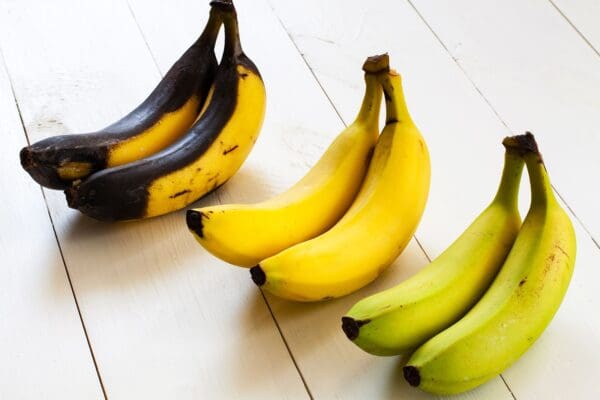
What to Look For 🔍
- Follow the ripeness stages above to choose bananas based on your needs.
- Consider how soon you plan to eat them—green bananas will ripen over time, while brown-spotted bananas are ready to eat immediately.
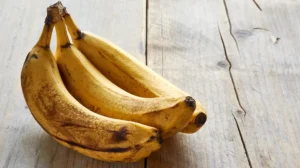
What to Avoid 🚫
- Bruised or damaged bananas as they may have been exposed to bacteria or insects.
- Strong fermented smell may indicate that it’s starting to spoil.
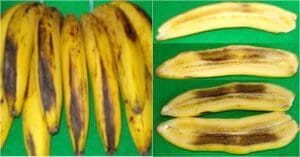
Storage Tips
- Room Temperature: Store bananas at room temperature if you want them to ripen naturally. Keep them in a cool, dry spot away from direct sunlight.
- Refrigeration: Once bananas reach your desired ripeness, you can refrigerate them to slow further ripening. The skin may darken, but the fruit inside will stay fresh.
- Freezing: For longer storage, peel and freeze bananas in an airtight container or bag. They’re perfect for smoothies or baking later.
How They’re Sold 🛒
- Typically sold in bunches and generally priced by weight.
Why Bananas? 🌟
- Nutritious, portable, and versatile.
- Great for snacks, baking, or adding to recipes.
- Easy to eat. Just peel.
Most Common Types of Bananas
(Banana score out of 5🍌🍌🍌🍌🍌)
Cavendish Bananas 🍌🍌🍌🍌🍌
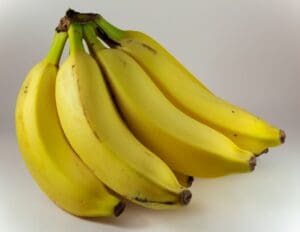
- Also Called: Supermarket Banana, Dessert Banana
- Flavor: Sweet, creamy, and mild.
- Best For: Snacking, smoothies, and desserts.
Plantains 🍌🍌🍌
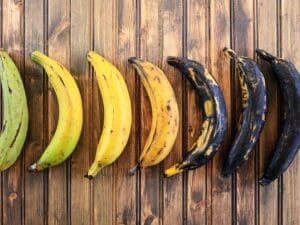
- Also Called: Cooking Banana, Platano, Green Banana
- Flavor: Starchy and less sweet when green; sweet and soft when ripe.
- Best For: Frying, boiling, or baking (common in savory dishes).
Lady Finger Bananas 🍌🍌🍌🍌
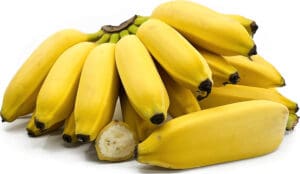
- Also Called: Baby Banana, Sugar Banana, Finger Banana
- Flavor: Sweeter and creamier than Cavendish bananas.
- Best For: Snacking, lunchboxes, and desserts.
Manzano Bananas 🍌🍌🍌🍌
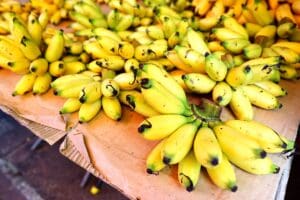
- Also Called: Apple Banana, Silk Banana
- Flavor: Sweet with hints of apple or strawberry.
- Best For: Snacking and fruit salads.
Thai Bananas / Vietnamese Bananas 🍌🍌🍌🍌🍌
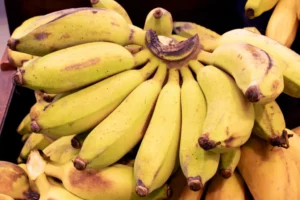
- Also Called: Pisang Awak, Kluai Namwa
- Flavor: Sweet and slightly tangy.
- Best For: Eating fresh, frying, or using in desserts.
